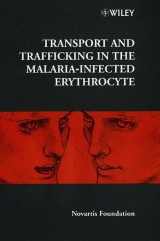Details

Transport and Trafficking in the Malaria-Infected Erythrocyte
Novartis Foundation Symposia, Band 226 1. Aufl.
|
108,99 € |
|
| Verlag: | Wiley |
| Format: | |
| Veröffentl.: | 30.04.2008 |
| ISBN/EAN: | 9780470515747 |
| Sprache: | englisch |
| Anzahl Seiten: | 304 |
DRM-geschütztes eBook, Sie benötigen z.B. Adobe Digital Editions und eine Adobe ID zum Lesen.
Beschreibungen
There is an urgent need to uncover new therapies that will protect against malaria, as the parasite becomes increasingly resistant to available drugs and this book offers insights into three interrelated aspects of the malaria-infected erythrocyte:<br /> <br /> * The transport of solutes into and out of the infected cell and the use of specific trafficking pathways in drug targeting<br /> <br /> * The traffic of proteins produced by the intracellular parasite as an essential process for the biogenesis of transport systems.<br /> <br /> * The relationship between the transport of drugs into the infected cell and the mode of drug action and drug resistance.
Introduction: host-parasite interrelations in the genomic age <p>H. GINSBURG</p> <p>Erythrocyte membrane transport</p> <p>Z. I. CABANTCHIK</p> <p>Chemical and physical in vitro alterations of the erythrocyte membrane: a model for its pathophysiological states?</p> <p>B. DEUTICKE</p> <p>The effects of transport perturbations on the homeostasis of red blood cells</p> <p>V. LEW and A.R. HOCKADAY</p> <p>Transport properties of the host cell membrane</p> <p>K. KIRK, H.M. STAINES, R.E. MARTIN and K.J. SALIBA</p> <p>Transport of phospholipid synthesis precursors and lipid trafficking into malaria-infected erythrocytes</p> <p>H.J. VIAL, P. ELDIN, D. MARTIN, L. GANNOUN, M. CALAS and M.L. ANCELIN</p> <p>A nutrient-permeable channel on the intraerythrocytic malaria parasite</p> <p>S.A. DESAI</p> <p>The permeability properties of the parasite cell membrane</p> <p>H. GINSBURG</p> <p>Macromolecular transport in malaria-infected erythrocytes</p> <p>T. F. TARASCHI</p> <p>Expression of parasite transporters in Xenopus oocytes</p> <p>S. KRISHNA and C.J. WOODROW</p> <p>Reconstitution of protein transport across the vacuolar membrane in Plasmodium falciparum-infected permeabilized erythrocytes</p> <p>S. BAUMEISTER, A. BURGWEDEL, U.-G. MAIER and K. LINGELBACH</p> <p>Export of parasite proteins to the erythrocyte cytoplasm: secretory machinery and signalling motifs</p> <p>F.R. ALBANO, M. FOLEY and L. TILLEY</p> <p>Transport and trafficking: Toxoplasma as a model for Plasmodium</p> <p>D.S. ROOS, M.J. CRAWFORD, R.G.K. DONALD, L.M. FOHL, K.M. HAGER, J.C. KISSINGER, M.G. REYNOLDS, B. STREIPEN and W.J. SULLIVAN Jr</p> <p>An alternative secretory pathway in Plasmodium: more questions than answers</p> <p>M.F. WISER, D.J. GRAB, and H.N. LANNERS</p> <p>The transport of the histidine-rich protein I from Plasmodium falciparum is insensitive to brefeldin A</p> <p>D. MATTEI, L. BERRY, S. COUFFIN and O. RICHARD</p> <p>Protein transport in the host cell cytoplasm and ATP-binding cassette proteins in Plasmodium falciparum-infected erythrocytes</p> <p>Z. BOZDECH and E. SCHURR</p> <p>Chloroquine uptake and activity is determined by binding to ferriprotoporphyrin IX in Plasmodium faciparum</p> <p>P.G. BRAY, O. JANNEH and S.A. WARD</p> <p>Chloroquine uptake, altered partiitioning and the basis of drug resistance: evidence for chloride dependent ionic regulation</p> <p>J.A. MARTINEY, A.S. FERRER, A. CERAMI, S. DZEKUNOV and P. ROEPE</p>
"...an excellent reference work for those in the field..." (Cell Biology International, Vol.26, No. 4, 2002)
The <strong>Novartis Foundation</strong> is an international scientific and educational charity which promotes the study and general knowledge of science and in particular encourages international co-operation in scientific research.
Malaria is a major infectious disease, affecting 500 million people and causing the death of around two million people each year. As the parasite becomes resistant to available drugs there is an urgent need to uncover new therapies that will protect against and cure this debilitating and fatal disease. Knowledge of specific physiological and biochemical processes in the malaria-infected erythrocyte could provide a basis for the development and targeting of such drugs. This book offers insights into three interrelated aspects of the malaria-infected erythrocyte: <ul> <li>The transport of solutes into and out of the infected cell and the use of specific trafficking pathways in drug targeting.</li> <li>The traffic of proteins produced by the intracellular parasite as an essential process for the biogenesis of transport systems.</li> <li>The relationship between the transport of drugs into the infected cell and the mode of drug action and drug resistance.</li> </ul>


















